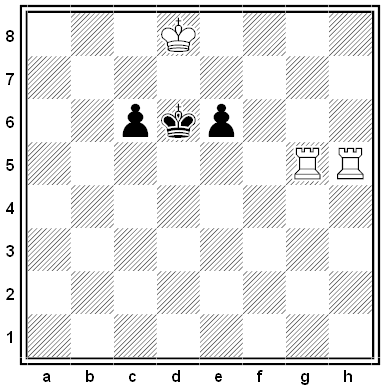Author: Greg Ross
Character Study
There is a game — in the 1950s it used to be played by members of the Iowa Writers’ Workshop — called ‘Smoke.’ It works as follows. The player who is ‘it’ chooses some famous person with whom everyone playing is surely acquainted (Harry Truman, Marlon Brando, Chairman Mao, Charles DeGaulle, for instance) and tells the other players, ‘I am a dead American,’ ‘I am a living American,’ ‘I am a dead Asian,’ ‘I am a dead European’; and then each of the other players in turn asks one question of the person who is ‘it,’ such as, ‘What kind of smoke are you?’ (cigarette, pipe, cigar — or, more specifically, L&M, Dunhill, White Owl) or ‘What kind of weather are you?’ ‘What kind of insect are you?’ or ‘What kind of transportation?’ The person who is ‘it’ answers not in terms of what kind of smoke his character would like, if any, but what kind of smoke he would be if, instead of being human, he were a smoke, or what kind of weather, insect, transportation, and so forth, he would be if reincarnated as one of those. Thus, for example, Kate Smith if an insect would be a turquoise beetle; Marlon Brando, if weather, would be sultry and uncertain, with storm warnings out; and as a vehicle of transporation Harry Truman would be (whatever he may in fact have driven) a Model T Ford. What invariably happens when this game is played by fairly sensitive people is that the whole crowd of questioners builds a stronger and stronger feeling of the character, by unconscious association, until finally someone says the right name — ‘Kate Smith!’ or ‘Chairman Mao!’ — and everyone in the room feels instantly that that’s right. There is obviously no way to play this game with the reasoning faculty, since it depends on unconscious associations or intuition; and what the game proves conclusively for everyone playing is that our associations are remarkably similar. When one of the players falls into some mistake, for instance, saing that Mr. Brezhnev of the U.S.S.R. is a beaver instead of, more properly, a crafty old woodchuck, all the players at the end of the game are sure to protest, ‘You misled us when you said “beaver.”‘ The game proves more dramatically than any argument can suggest the mysterious rightness of a good metaphor — the one requisite for the poet, Aristotle says, that cannot be taught.
— John Gardner, On Moral Fiction, 1978
A Letter Home
Young telegraph operator Joseph Orton Kerbey was enlisted as a spy for the federal forces during the Civil War. In 1861, laid up in a sick bed in Richmond, he needed a way to communicate his latest discoveries to his friends in the north. The message would have to appear innocent and contain the key to its own decipherment. Here’s what he sent:
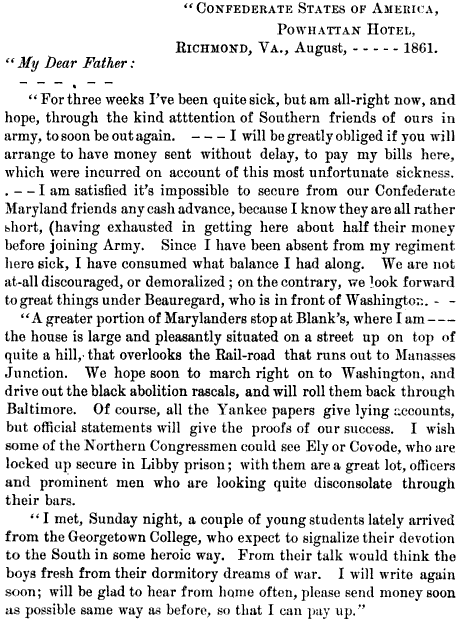
He directed it, not to his father’s name and address, but to a friend in the telegraph office at Annapolis. What was the hidden message?
In a Word
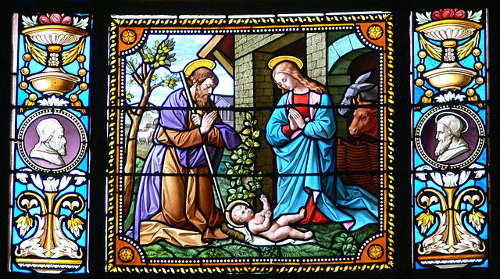
nullipara
n. a childless woman
vagitus
n. a newborn child’s cry
deiparous
adj. giving birth to a god
Transcendence
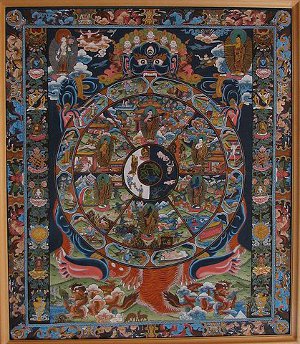
In Western religion we seek to attain immortality; in Eastern religion we seek to escape it.
“The secret of religious enlightenment, revealed to the Buddha as he sat beneath the Bo tree, is the suppression of desire, a systematic elimination of all our attachments to the world,” writes Gordon Graham in his Eight Theories of Ethics. “In such turning away comes moksha or release and eventually, for it may take more than one life to achieve it, entry to Nirvana — a term which captures both the idea of nothingness and of heaven. The Buddhist ideal, then, finds supreme value in personal extinction. (Whether this amounts to total extinction is a further matter.) In so doing it wholly discounts subjective values because it is these, after all, that keep us chained to the unending cycle of birth, death and rebirth.
“It is of great interest to note that, while Western minds are accustomed to think of religious faith as entailing the belief and hope that we will be saved from eternal death and live for ever, the belief of Eastern religions is that, other things being equal, we do live for ever and it is from this dreadful fate that we must look to spirituality to save us.”
Required Reading
In 1990, Spanish philosopher Jon Perez Laraudogoitia submitted an article to Mind entitled “This Article Should Not Be Rejected by Mind.” In it, he argued:
- If statement 1 in this argument is trivially true, then this article should be accepted.
- If statement 1 were false, then its antecedent (“statement 1 in this argument is trivially true”) would be true, which means that statement 1 itself would be true, a contradiction. So statement 1 must be true.
- But that seems wrong, since Mind is a serious journal and shouldn’t publish trivial truths.
- That means statement 1 must be either false or a non-trivial truth. We know it can’t be false (#2), so it must be a non-trivial truth, and its antecedent (“statement 1 in this argument is trivially true”) is false.
- What then is the truth value of its consequent, “this article should be accepted”? If this were false then Mind shouldn’t publish the article; that can’t be right, since the article consists of a non-trivial truth and its justification.
- So the consequent must be true, and Mind should publish the article.
They published it. “This is, I believe, the first article in the whole history of philosophy the content of which is concerned exclusively with its own self, or, in other words, which is totally self-referential,” Laraudogoitia wrote. “The reason why it is published is because in it there is a proof that it should not be rejected and that is all.”
Rise or Fall
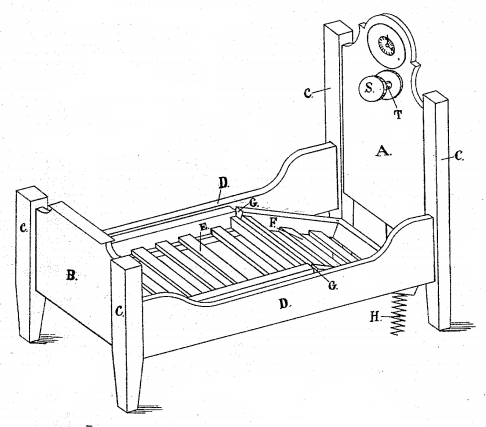
Here’s an old-timey way to prevent oversleeping, patented by A.J. Nordmann in 1885. Set your alarm clock as normal but attach it to a lever on Nordmann’s “alarm and waking bed.” Now if you don’t turn off the alarm in time, the head of the bedframe will drop to the floor.
“Thus a person sleeping is awakened as the alarm sounds, and should he fail to rise he is immediately dropped down with the head portion of the mattress F, which then has its bearing upon the springs H.”
I suppose that really chronic oversleepers could remove the springs, to make the jolt even more jarring.
“A Memory”
When I was as high as that
I saw a poet in his hat.
I think the poet must have smiled
At such a solemn gazing child.
Now wasn’t it a funny thing
To get a sight of J.M. Synge,
And notice nothing but his hat?
Yet life is often queer like that.
— L.A.G. Strong
Tit for Tat
On March 19, 1884, the French cargo ship Frigorifique was cruising through heavy fog in the Bay of Biscay when the British steamer Rumney loomed out of nowhere and struck it amidships. The French crew scrambled aboard the Rumney, and their own ship disappeared into the fog.
Some time later, while the injured Rumney was still lowering its boats, another ship hove out of the fog and struck it amidships. This proved to be the empty Frigorifique — her jammed rudder had led her in a great circle through the fog to return for a second collision.
Both ships sank this time, but the crews escaped safely in the Rumney‘s lifeboats.
20 to 3
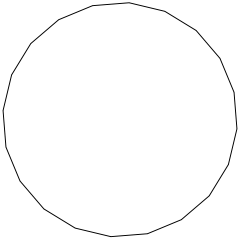
Prove that, if we choose nine vertices of a regular icosagon, some three of these will form an isosceles triangle.

